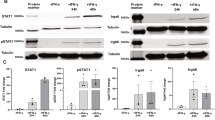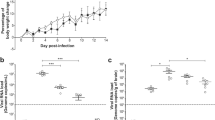Abstract
A number of studies have suggested that macrophages, dendritic cells, and follicular dendritic cells play an important role in the propagation of PrPSc. Both accumulation and proteolysis of PrPSc have been demonstrated in peripheral macrophages. Macrophages may act as reservoirs for PrPSc particles if the cells die during transient PrPSc propagation. However, whether cell death plays a role in PrPSc propagation in macrophages remains unclear. In this study, we investigated the possibility of propagation and transmission of PrPSc between dead immune cells and living neural cells. We found that under specific conditions, transient PrPSc propagation occurs in dead cells, indicating that interaction between PrPC and PrPSc on plasma membrane lipid rafts might be important for PrPSc propagation. Co-culturing of killed donor PrPSc-infected macrophages with recipient N2a-3 neuroblastoma cells accelerated PrPSc transmission. Our results suggest that cell death may play an important role in PrPSc propagation, whereas transient PrPSc propagation in macrophages has little effect on PrPSc transmission.



Similar content being viewed by others
References
Aguzzi A (2003) Prions and the immune system: a journey through gut, spleen, and nerves. Adv Immunol 81:123–171
Andréoletti Q, Berthon P, Marc D, Sarradin P, Grosclaude JJ, van Keulen L, Schelcher F, Elsen JM, Lantier F (2000) Early accumulation of PrPSc in gut-associated lymphoid and nervous tissues of susceptible sheep from a Romanov flock with natural scrapie. J Gen Virol 81:3115–3126
Beringue V, Couvreur P, Dormont D (2002) Involvement of macrophages in the pathogenesis of transmissible spongiform encephalopathies. Dev Immunol 9:19–27
Bruce ME, Brown KL, Mabbot NA, Farquhar CF, Jeffrey M (2000) Follicular dendritic cells in TSE pathogenesis. Immunol Today 21:442–446
Campana V, Sarnataro D, Zurzolo C (2005) The highways and byways of prion protein trafficking. Trends Cell Biol 15:102–111
Chandler RL, Fisher J (1963) Experimental transmission of scrapie to rats. Lancet 2:1165
Collinge JJ (2001) Prion diseases of humans and animals: their causes and molecular basis. Annu Rev Neurosci 24:519–550
DebBurman SK, Raymond GJ, Caughey B, Lindquist S (1997) Chaperone-supervised conversion of prion protein to its protease-resistant form. Proc Natl Acad Sci USA 94:13938–13943
Deleault NR, Lucassen RW, Supattapone S (2003) RNA molecules stimulate prion protein conversion. Nature 425:717–720
Dubowchik GM, Padilla L, Edinger K, Firestone RA (1994) Reversal of doxorubicin resistance and catalytic neutralization of lysosomes by a lipophilic imidazole. Biochim Biophys Acta 1191:103–108
Elhelaly AE, Inoshima Y, Ishiguro N (2012) Alteration of cell responses to PrPSc in prolonged cell culture and its effect on transmission of PrPSc to neural cells. Arch Virol 158:651–658
Elhelaly AE, Inoshima Y, Ishiguro N (2013) Characterization of early transient accumulation of PrPSc in immune cells. Biochem Biophys Res Commun 439:340–345
Haïk S, Faucheux BA, Hauw JJ (2004) Brain targeting through the autonomous nervous system: lessons from prion diseases. Trends Mol Med 10:107–112
Herrmann LM, Cheevers WP, Davis WC, Knowles DP, O’Rourke KI (2003) CD21-positive follicular dendritic cells: a possible source of PrPSc in lymph node macrophages of scrapie-infected sheep. Am J Pathol 162:1075–1081
Kim CL, Umetani A, Matsui T, Ishiguro N, Shinagawa M, Horiuchi M (2004) Antigenic characterization of an abnormal isoform of prion protein using a new diverse panel of monoclonal antibodies. Virology 320:40–51
Kujala P, Raymond CR, Romeijn M, Godsave SF, van Kasteren SL, Wille H, Prusiner SB, Mabbott NA, Peters PJ (2011) Prion uptake in the gut: identification of the first uptake and replication sites. PLoS Pathog 7:e1002449
Prusiner SB (1991) Molecular biology of prion diseases. Science 252:1515–1522
Prusiner SB (1998) Prions. Proc Natl Acad Sci USA 95:13363–13383
Saborio GP, Permanne B, Soto C (2001) Sensitive detection of pathological prion protein by cyclic amplification of protein misfolding. Nature 411:810–813
Sassa Y, Yamasaki T, Horiuchi M, Inoshima Y, Ishiguro N (2010) The effects of lysosomal and proteasomal inhibitors on abnormal forms of prion protein degradation in murine macrophages. Microbiol Immunol 54:763–768
Shinagawa M, Munekata E, Doi S, Takahashi K, Goto H, Sato G (1986) Immunoreactivity of a synthetic pentadecapeptide corresponding to the N-terminal region of the scrapie prion protein. J Gen Virol 67:1745–1750
Tanaka Y, Sadaike T, Inoshima Y, Ishiguro N (2012) Characterization of PrPSc transmission from immune cells to neuronal cells. Cell Immunol 279:145–150
Taraboulos A, Scott M, Semenov A, Avrahami D, Laszlo LL, Prusiner SB (1995) Cholesterol depletion and modification of COOH-terminal targeting sequence of the prion protein inhibit formation of the scrapie isoform. J Cell Biol 129:121–132
Uryu M, Karino A, Kamihara Y, Horiuchi M (2007) Characterization of prion susceptibility in Neuro2a mouse neuroblastoma cell subclones. Microbiol Immunol 51:661–669
Wadsworth JD, Joiner S, Hill AF, Campbell TA, Desbruslais M, Luthert PJ, Collinge J (2001) Tissue distribution of protease resistant prion protein in variant Creutzfeldt–Jakob disease using a highly sensitive immunoblotting assay. Lancet 358:171–180
Wong C, Xiong LW, Horiuchi M, Raymond L, Wehrly K, Chesebro B, Caughey B (2001) Sulfated glycans and elevated temperature stimulate PrPSc-dependent cell-free formation of protease-resistant prion protein. EMBO J 20:377–386
Acknowledgments
This work was supported by a grant (22380165) from the Ministry of Education, Culture, Sports, Science, and Technology and by a grant from the Ministry of Health, Labour, and Welfare of Japan.
Author information
Authors and Affiliations
Corresponding author
Rights and permissions
About this article
Cite this article
Takahashi, K., Inoshima, Y. & Ishiguro, N. Role of cell death in the propagation of PrPSc in immune cells. Arch Virol 160, 693–699 (2015). https://doi.org/10.1007/s00705-014-2320-z
Received:
Accepted:
Published:
Issue Date:
DOI: https://doi.org/10.1007/s00705-014-2320-z




